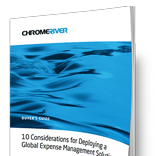
To reveal hidden trends and opportunities, companies can use analytics software to sift enormous amounts of data, looking for an edge. As businesses seek to benefit from “big data,” managers increasingly rely on analytics-based reports to guide their decision-making, according to a post on the Big Fat Finance Blog. A great way for your company to benefit from big-data analytics is by using expense management software.
Good expense management software like Chrome River EXPENSE helps executives spot trends and improve their business expense tracking, and it delivers transparency around all your cost centers. The most common analytics tools are descriptive, according to Big Fat Finance, providing detailed outlines of current business situations. In expense management, for example, executives might use a product like Chrome River ANALYTICS to review past expenses, analyze current ones, and compare past and present amounts.
Finding it difficult to choose the best analytics tools for your business? Big Fat Finance includes a number of features to consider. They suggest companies find a solution that …
- Connects a complete company overview to detailed data. Users should be able to track global and departmental spending and cost center activity, but also drill down to such details as individual user activity.
- Provides value by combining robust features and low cost. Some cloud-based analytics systems also allow employees to work in a disconnected mode, which can offer significant network cost savings.
- Stores data securely, while providing convenient access. Using a cloud-based analytics service means you no longer need to secure data in-house. A cloud-based platform makes powerful expense management applications readily available via web portals and secure mobile apps.
- Requires minimal IT intervention. If you’d rather not involve IT in these projects, intuitive, cloud-based expense management software can help employees generate even complex reports, charts and dashboards from multiple enterprise information sources.
- Interacts smoothly and securely with other business intelligence tools. Look for solutions that integrate with your proprietary systems and multidimensional enterprise-information sources.
- Produces flexible, customizable reports and displays. A good solution should allow users to easily create dashboards and output reports in a variety of formats, like HTML, Excel and PowerPoint.
If you want fast, effective decision-making and smooth daily operations, make it easy for employees of all skill levels to create the reports and analyses they need. Choosing the best expense report software provides the tools you need to do that.
What analytics tools does your business use? What features have you found to be most important? Share your thoughts below in the comments section!
Search
Subscribe
Latest Posts
Posts by Category
Our choice of Chrome River EXPENSE was made in part due to the very user-friendly interface, easy configurability, and the clear commitment to impactful customer service – all aspects in which Chrome River was the clear winner. While Chrome River is not as large as some of the other vendors we considered, we found that to be a benefit and our due diligence showed that it could support us as well as any large players in the space, along with a personalized level of customer care.
We are excited to be able to enforce much more stringent compliance to our expense guidelines and significantly enhance our expense reporting and analytics. By automating these processes, we will be able to free up AP time formerly spent on manual administrative tasks, and enhance the role by being much more strategic.
